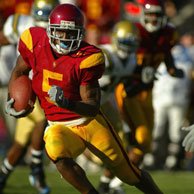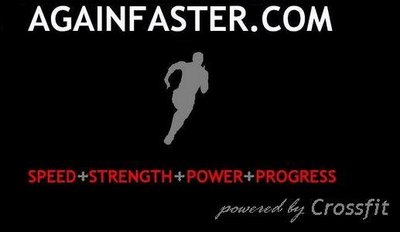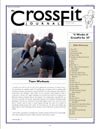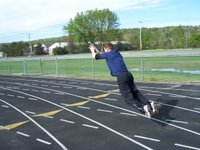Speed Kills

Speed is a key differentiator among athletes. If two athletes are compared in nearly any sport, the faster athlete performs better. The faster running back accumulates more yards. The faster baseball player has a higher fielding percentage and more stolen bases. The faster sprinter wins the race.
Speed has many components: straight-line acceleration, lateral acceleration, deceleration, change of direction, and constant speed. The relative importance of these components varies among athletes.
The sprinter seeks straight-line acceleration and speed maintenance. The running back needs every component of speed to perform effectively. This combination of acceleration, deceleration, and straight-line speed is often referred to as agility. The baseball player needs agility in the field, and straight-line acceleration on the base paths.
The recreational runner may or may not value speed. Like the professional sprint athlete, a recreational sprinter needs straight-line acceleration and speed maintenance. The marathoner wants to keep a certain pace, and increase that pace if possible, but has little regard for acceleration.
In the Crossfit Community, we’ve talked time and time again about the superiority of sprinting over long, slow distance (LSD) training. Sprinting relies on power output. We want to cover the most distance in the least time. Sprinting calls on the ATP-PC pathway and anaerobic glycolysis rather than the aerobic metabolism—the duration of a sprint is typically less than one minute, eliminating the aerobic metabolism from activation.
The ATP-PC and anaerobic energy systems are associated with high power output. Their repeated use manifests itself in increased muscle mass.
The typical black-box observation: the physiques of distance runners and sprinters are very different—the latter are much more developed.
Which physique would you rather have?
Despite our knowledge of the benefits of sprinting, we don’t spend too much time optimizing our sprint performance. The instruction consists of “Go run fast.”
On Sunday, Samantha and I made a crude attempt at sprint analysis. Given our general physical fitness, it seems reasonable that we can learn to sprint faster.
We took video and still pictures of the 100m and the 40 yard dash in an attempt to identify mechanical weaknesses in our sprinting. By and large, we didn’t succeed, due to the quality of our images and our lack of knowledge regarding proper sprint mechanics. Nonetheless, our times bear witness to the need for coaching.
My best 100m time was 14.23 seconds. In comparison, Justin Gatlin, the world’s fastest man, recently ran the 100 in 9.77. This time equals the existing world record. Mine doesn’t even come close. I have no illusions about a 10 second 100, but I’d like a slightly more respectable time.
According to Jeff L. Hoskisson, the Assistant Track Coach at Western Michigan University, sprinting boils down to optimum stride length and maximum stride rate.
To paraphrase, stride length cannot be too long, or the runner will slow down. The foot landing too far in front of the center of mass results in a braking effect. The foot should land as close as possible to the center of mass.
Stride rate is simply the number of strides taken per unit time. The runner seeks to maximize this metric. If stride length is constant and optimal, more strides result in faster sprinting. Mr. Hoskisson cites a 1990 Mann study which found that elite 100 meter athletes are moving at nearly 19 miles per hour!
Hoskisson notes that the amount of time the sprinter is in contact with the ground has an inverse relationship to speed. Nearly all sprinters spend the same amount of time in the air, but ground time varies. Less ground time, faster sprinting.
He also describes optimal mechanics for each phase of the sprint cycle, from takeoff to touchdown. You can read the details in his article, Sprint Mechanics Revisited.
Speed kills, and maximizing sprint speed will have a great effect on your overall athleticism and body composition. As I learn more about sprinting, I will share the knowledge.
Maybe I’ll wait until after we race.
Do not think of speed as an innate quality—I believe it can be taught. Like the O-lifts, optimizing technique should have a profound effect on exercise quality.

Speed is a key differentiator among athletes. If two athletes are compared in nearly any sport, the faster athlete performs better. The faster running back accumulates more yards. The faster baseball player has a higher fielding percentage and more stolen bases. The faster sprinter wins the race.
Speed has many components: straight-line acceleration, lateral acceleration, deceleration, change of direction, and constant speed. The relative importance of these components varies among athletes.
The sprinter seeks straight-line acceleration and speed maintenance. The running back needs every component of speed to perform effectively. This combination of acceleration, deceleration, and straight-line speed is often referred to as agility. The baseball player needs agility in the field, and straight-line acceleration on the base paths.
The recreational runner may or may not value speed. Like the professional sprint athlete, a recreational sprinter needs straight-line acceleration and speed maintenance. The marathoner wants to keep a certain pace, and increase that pace if possible, but has little regard for acceleration.
In the Crossfit Community, we’ve talked time and time again about the superiority of sprinting over long, slow distance (LSD) training. Sprinting relies on power output. We want to cover the most distance in the least time. Sprinting calls on the ATP-PC pathway and anaerobic glycolysis rather than the aerobic metabolism—the duration of a sprint is typically less than one minute, eliminating the aerobic metabolism from activation.
The ATP-PC and anaerobic energy systems are associated with high power output. Their repeated use manifests itself in increased muscle mass.
The typical black-box observation: the physiques of distance runners and sprinters are very different—the latter are much more developed.
Which physique would you rather have?
Despite our knowledge of the benefits of sprinting, we don’t spend too much time optimizing our sprint performance. The instruction consists of “Go run fast.”
On Sunday, Samantha and I made a crude attempt at sprint analysis. Given our general physical fitness, it seems reasonable that we can learn to sprint faster.
We took video and still pictures of the 100m and the 40 yard dash in an attempt to identify mechanical weaknesses in our sprinting. By and large, we didn’t succeed, due to the quality of our images and our lack of knowledge regarding proper sprint mechanics. Nonetheless, our times bear witness to the need for coaching.
My best 100m time was 14.23 seconds. In comparison, Justin Gatlin, the world’s fastest man, recently ran the 100 in 9.77. This time equals the existing world record. Mine doesn’t even come close. I have no illusions about a 10 second 100, but I’d like a slightly more respectable time.
According to Jeff L. Hoskisson, the Assistant Track Coach at Western Michigan University, sprinting boils down to optimum stride length and maximum stride rate.
To paraphrase, stride length cannot be too long, or the runner will slow down. The foot landing too far in front of the center of mass results in a braking effect. The foot should land as close as possible to the center of mass.
Stride rate is simply the number of strides taken per unit time. The runner seeks to maximize this metric. If stride length is constant and optimal, more strides result in faster sprinting. Mr. Hoskisson cites a 1990 Mann study which found that elite 100 meter athletes are moving at nearly 19 miles per hour!
Hoskisson notes that the amount of time the sprinter is in contact with the ground has an inverse relationship to speed. Nearly all sprinters spend the same amount of time in the air, but ground time varies. Less ground time, faster sprinting.
He also describes optimal mechanics for each phase of the sprint cycle, from takeoff to touchdown. You can read the details in his article, Sprint Mechanics Revisited.
Speed kills, and maximizing sprint speed will have a great effect on your overall athleticism and body composition. As I learn more about sprinting, I will share the knowledge.
Maybe I’ll wait until after we race.
Do not think of speed as an innate quality—I believe it can be taught. Like the O-lifts, optimizing technique should have a profound effect on exercise quality.




















0 Comments:
Post a Comment
<< Home